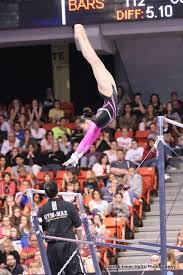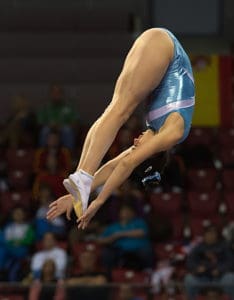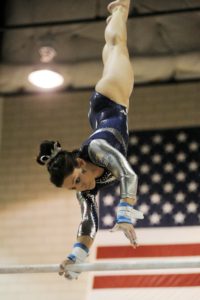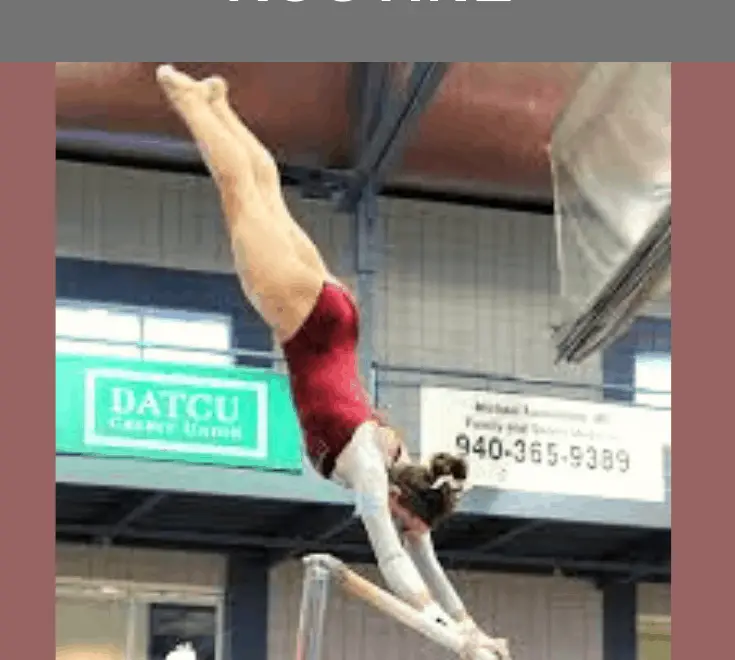This post has been updated to reflect the changes in the 2022-2026 DP Code of Points.
Bar routines start to get a lot more complicated once you get to Level 9! There are more requirements, more choices, bonus connections… it’s enough to make anyone’s head spin! If you’re trying to decide how to construct your Level 9 bar routine, keep reading. Here’s a breakdown of all the components a great routine will need!
Overview of Level 9 Bars
Level 9 is an advanced optional level. In each optional level, gymnasts must perform a set number of skills with different values (Value Parts) as well as skills from specific categories (Special Requirements).
Level 9 is the first level in which the routine does not start from a 10.0, and the gymnast needs to earn bonus to get to the 10.0 Start Value. If all Value Parts and Special Requirements are fulfilled, the maximum score is 9.7. A gymnast can earn a maximum of 0.30 in bonus, which will bring the Start Value up to a 10.0.
Execution and amplitude deductions are taken throughout the routine, with an emphasis on clean form and handstand positions throughout.
After the routine is complete, the judges will evaluate the difficulty of the skills performed, and additional deductions can be taken if the routine does not meet certain criteria. We’ll talk more about that later.
Value Parts in a Level 9 Bar Routine
Just like Level 8 and Level 10, each Level 9 bar routine has a certain number of skills required at different values. For maximum value at Level 9, gymnasts need 3 A’s, 4 B’s, and 1 C in their routine. Most times, if the Special Requirements are met, these Value Parts will also be met. However, it’s always good to count them up just to be sure. A’s are worth 0.10, B’s are worth 0.30, and C’s are worth 0.50.
Skills can receive Value Part credit two times, as long as they are performed in a different connection. This means that there must be a different skill performed either before or after it. If a skill is performed a third time, it will not receive Value Part credit, and it is not eligible to fulfill Special Requirements.
A Level 9 bar routine can include any D skills from the allowable D list. Allowable D skills for Level 9 bars consist of skills with a B or C root element with a full pirouette, or a 1/2 turn to reverse, L, or mixed L grip.
Examples of allowable D’s for Level 9 bars:
- Cast handstand 1/1 pirouette
- Giant 1/1 pirouette
- Clear hip circle 1/1 pirouette
- Stalder 1/1 pirouette
- Sole circle to handstand 1/1 pirouette
- Clear hip circle 1/2 turn to reverse grip
- Stalder 1/2 turn to L grip
- Sole circle to handstand 1/2 turn to mixed L grip
The routine may also include one restricted D/E element, which is any D or E element that does not fulfill the criteria above. The restricted D/E elements are counted in chronological order, and any additional restricted D/E’s receive a 0.5 deduction off the Start Value. Restricted D/E elements beyond the one allowable will not receive Value Part or Special Requirement credit.
Examples of restricted D/E elements:
- Pak salto
- Bail to handstand
- Maloney
- Double layout dismount
- There are countless more examples in the Code, but the first two on this list are by far the most common ones that I see.
Special Requirements for Level 9 Bars

There are four special Requirements for a Level 9 bar routine. In order to receive the maximum Start Value, the gymnast must complete all four Special Requirements. The Level 9 Special Requirements are:
- Two Bar Changes
- One B Flight Element
- Second Flight Element (C) OR B LA Turn
- B salto Dismount
Two Bar Changes
Each time a gymnast moves from the low bar to the high bar, or vice versa, this is considered a bar change. Level 9 gymnasts must change bars at least two times, or they will receive a 0.50 deduction from the Start Value. There is no requirement for the level of the skills used to transition between bars, but many gymnasts use one or both of these transitions as an opportunity to perform a flight element and fulfill another Special Requirement.
B Flight Element
A flight element, or release, is a skill in which the hands release and regrasp the bar. Flight elements can be performed on the same bar, or they can be used as transitions from one bar to the other. In Level 9, most flight elements are transitions from low bar to high bar or vice versa. Here are some examples, although these lists are not all-inclusive.
Examples of low-high releases:
- Toe hecht (C)
- Shaposhnikova/Maloney (restricted D)
Examples of high-low releases:
- Straddle back to support (B)
- Bail to support from support (B)
- Straddle back to support from handstand (C)
- Straddle back to handstand (C) – if it comes from HS, it’s a restricted D
- Peach (C)
- Bail to support from handstand (C)
- Bail to handstand (restricted D)
- Pak salto (restricted D)
Examples of same-bar releases:
- Straddle cut (B)
- Cast handstand-hop to reverse grip (C)
- Giant-hop to reverse grip (C)
2nd Flight Element (C) or B LA turn
For this requirement, the gymnast must perform a C flight element, or a B turning element. She can choose one of the C flights from the list above, or a B turn from the following list.
Examples of LA turns:
- Swing ½ turn at 21-44 from vertical (B)
- Turning uprise (B)
- Bail from support to support (B)
- Bail from handstand to support (C)
- Cast handstand ½ pirouette (also blind change, Higgins, or Healy) (C)
- Clear hip ½ pirouette, Stalder ½ pirouette, or sole circle ½ pirouette (C)
- Giant ½ turn – any technique (C)
- Front giant ½ turn or Healy (C)
- Uprise to handstand ½ pirouette (C)
- Bail to handstand (restricted D)
If she chooses to perform an element with LA turn for this requirement, and it has flight, it CANNOT also fulfill the 2nd Special Requirement of a B flight element. These two requirements must be fulfilled by two separate elements.
B Salto Dismount

A gymnast must perform a dismount of at least B value to fulfill this requirement.
Examples of B dismounts:
- Flyaway with ½ twist
- Flyaway with 1/1 twist
- Front flyaway with ½ twist
- Front flyaway with 1/1 twist
- Facing LB – cast to near handstand, front tuck salto dismount
Examples of C dismounts:
- Double tuck flyaway
- Double pike flyaway
- Comaneci salto
- Toe-on front (tucked, piked, or with ½ twist)
- Flyaway with 1 ½ or 2/1 twist
- Front flyaway with 1 ½ or 2/1 twist
- Facing LB – cast to near handstand, front pike salto dismount
- Facing LB – cast to near handstand, back tuck or pike salto dismount
- Facing LB – Clear hip circle to back tuck or pike salto dismount
- Facing LB – Giant circle to back tuck salto dismount (Gonzales)
Bonus Opportunities

At level 9, bonus comes from connective value, or connecting two difficult skills together, OR by performing a D/E Value Part.
Bonus can be awarded through the following connections:
- C+C (neither element with turn or flight) – +0.10
To receive this bonus, elements MUST be different. - C+C (one element with turn or flight) – +0.10
- C+C (both elements with turn or flight) – +0.20
In addition, Level 9 gymnasts can receive D/E bonus of +0.10 for ONE D/E element. If a gymnast performs an E element, she will only receive +0.10 bonus (unlike Level 10, in which E’s receive +0.20).
Bonus is not awarded if the gymnast falls or is spotted.
NOTE: D/E elements count as C’s when awarding connection bonus.
Clarification on Awarding of D/E Bonus
If a gymnast attempts a D/E element and falls, a couple of different things can happen, depending on whether the skill gets Value Part credit. Let’s take a look at a couple of examples.
Example #1:
Gymnast performs Pak salto, does not touch her hands, and falls.
- NO VP credit is given. NO SR credit is given. NO bonus is given.
Gymnast remounts the bars and completes the Pak salto.
- NO deduction will be taken for a restricted element, because the first attempt at the Pak did not receive VP credit.
- VP credit IS given. SR credit IS given. She WILL earn the +0.10 D/E bonus, and if she performs it in connection, she is eligible for connection bonus.
- If she performs an ALLOWABLE D later in the routine, it is NOT eligible for D/E bonus.
Example #2:
Gymnast performs Pak salto, touches her hands, and falls.
- VP credit is given. SR credit is given. NO bonus is given.
- If she remounts and performs the Pak again (for instance, to get connection bonus), she WILL receive a 0.50 deduction for a 2nd restricted D.
- If she performs an ALLOWABLE D later in the routine, that D would be eligible for +0.10 D/E bonus.
Clear as mud? You may need to read it a few times. I know I had to read it multiple times and then hear it again during a clinic, and then it finally made sense.
Composition Deductions
A routine that fulfills all of the Value Parts and Special Requirements may still be subject to other deductions related to the quality of the skills in the routine. These deductions, called composition deductions, reward gymnasts that use more difficult skills to fulfill their requirements.
Here are the Level 9 composition deductions:
- Choice of elements: Failure to perform elements (min. B) that meet 2 of the following 3 categories:
- 1. Forward element, minimum B
- 2. Group 3/6/7 element, minimum B
- 3. Element with LA turn, minimum C
- 2/3 categories performed – NO deduction
- 1/3 categories performed – 0.10 deduction
- 0/3 categories performed – 0.20 deduction
- Facing same direction throughout exercise (1/1 turn or mount/dismount will NOT fulfill this category) – 0.10
- Uncharacteristic element – 0.10 each time
- Dismount not up to the level
- C – NO deduction
- C+B – 0.05
- B+B – 0.10
It’s simple to get one of the 3 element choice categories using a skill with LA turn to fulfill the Special Requirement. If it’s a skill with a ½ turn, it will also fulfill the directional composition requirement. It’s great when one skill can meet multiple requirements! If the gymnast has a clean skill from Group 3/6/7 (which is likely, because that was a requirement in Levels 6, 7, and 8), put that in too, and boom, your choice requirement is done!
Final Thoughts
Now you know how to construct a great Level 9 bar routine. But don’t forget the most important part – clean execution and strong handstands. Always critically evaluate each skill to be sure it is performed well. A poorly performed difficult skill or combination will likely lose more points than it earns. Straight body position, straight arms and legs, and good foot form are key to a great bars score.
The other important piece of a Level 9 bar routine is precise handstand positions. For no deduction, handstands should be within 10 of vertical. Each skill has different criteria that it must meet in order to minimize deductions. See What’s Your Bar Angle for more specifics.
In summary, choose skills the gymnast can perform well, that meet the Special Requirements and Value Part requirements. To start from a 10.0, the gymnast will need to combine C skills to earn 0.30 in connection bonus. Check the composition deductions, and try to include skills that meet all of these requirements. And finally, hit your handstands with good body position!
Further Reading
The Ultimate Guide to Gymnastics Grips
Level 8 Bar Routine Composition
Level 10 Bar Routine Composition
References
USA Gymnastics J.O. Code of Points, 2022-2026.

film says:
I conceive you have observed some very interesting points, regards for the post. Monique Mason Nickolaus